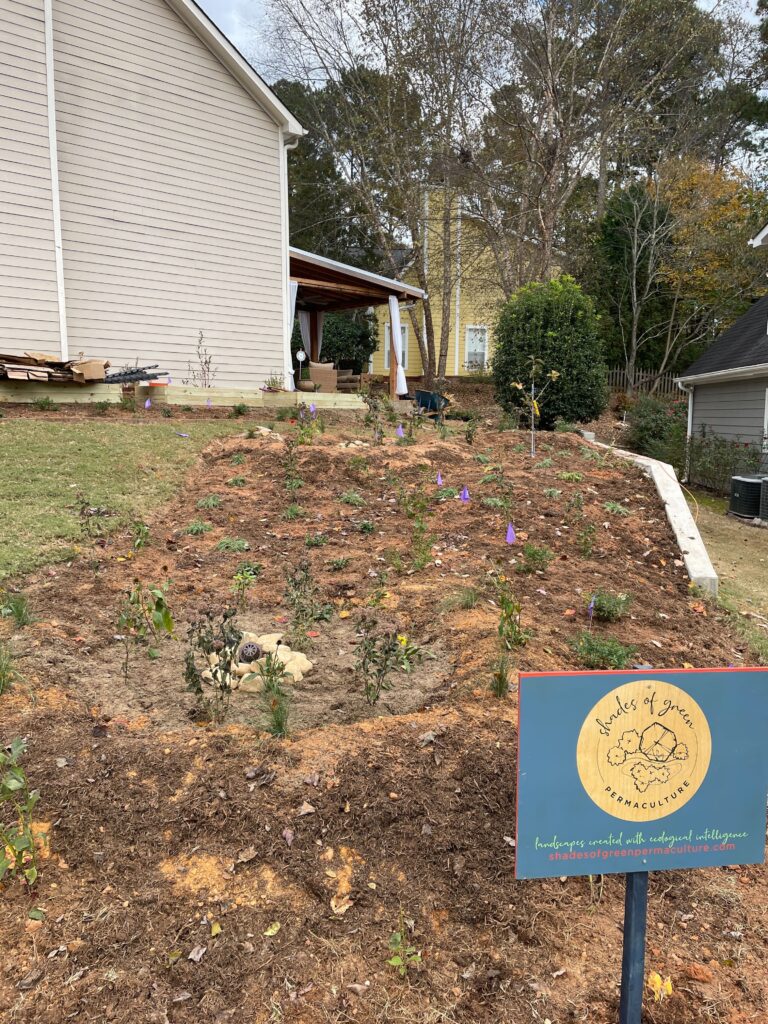What is Slow Landscaping?
At its core, slow landscaping is the antithesis of instant gratification. Instead of rushing to create a “finished” garden in a weekend or season, it invites you to engage with the land over time. This approach values long-term sustainability, natural processes, and thoughtful design choices that reflect the unique qualities of your environment. It encourages us to move away from the mentality of instant green lawns or quickly assembled ornamental flower beds and instead focus on nurturing regenerative and resilient ecosystems, oftentimes through permaculture.
It takes time for a regenerative or permaculture garden to establish itself—at least two growing seasons. Consider this: For every inch in diameter a tree trunk measures, it will take that many growing seasons after being planted or transplanted before it is established enough to put on new growth.
- Before
- Immediately after installation
Our go-to principles of slow landscaping
Practicing Patience. Slow landscaping honors the idea that good things take time. Whether it’s waiting for a native wildflower meadow to fully establish or allowing trees to mature over decades, slow landscaping teaches patience. It’s about letting plants grow into their space, observing how they adapt to your climate, and learning to appreciate the beauty of each stage of development.
Work With Nature, Not Against It. A key aspect of slow landscaping is understanding and honoring the natural processes already at work. This means using permaculture principles like companion planting, building healthy soil, and welcoming wildlife. Instead of forcing a landscape into a predetermined aesthetic, slow landscaping encourages you to observe how nature shapes the land and work within those patterns.
Sustainability at the Forefront. Quick fixes often involve shortcuts that can be damaging in the long term, such as excessive use of synthetic fertilizers, pesticides, or unsustainable water practices. Slow landscaping, on the other hand, prioritizes practices that enrich the land over time. Mulching, composting, rainwater harvesting, and using native plants all contribute to a healthier ecosystem that requires fewer external inputs.
Seasonal Awareness. Just as nature has its seasons, so too does a slow landscape. A well-designed garden will have something to offer in every season—whether it’s the blooms of spring, the fruits of summer, the golden hues of autumn, or the stillness of winter. Slow landscaping celebrates this cyclical change, encouraging us to live in harmony with the seasonal shifts instead of striving for constant, year-round perfection.
Biodiversity and Balance. Fast-paced landscaping often results in monocultures, such as lawns or single-species plantings that are prone to pests and disease. Slow landscaping promotes biodiversity by encouraging a rich variety of plants, trees, and flowers that attract beneficial insects, birds, and other wildlife. This creates a balanced ecosystem that can better resist challenges and thrive in the long run. We especially love bring this forward through our regenerative lawn care service.
- After
- Installation
- Three years
- later
Getting Started
- Observe: Spend time in your space before making any changes. Watch how the sun moves, where water collects, and how wildlife interacts with the plants.
- Plant Native: Choose plants that are native to your region, as they will require less water, fewer resources, and support local ecosystems.
- Build Soil Health: Focus on enriching the soil through composting, mulching, and organic amendments. Healthy soil is the foundation of a thriving landscape.
- Plan for the Long Term: Instead of seeking immediate results, think about how you want your garden to evolve over the years. Plant trees that will provide shade in decades to come, or design areas that will bloom differently each season.
- Welcome wildlife: Encourage birds, bees, and other beneficial creatures by providing food, water, and shelter in your landscape.
Let this journey remind us that growth takes time! Trust the process and let the roots grow deep. It takes time for seasons to change, rainwater to infiltrate, and sunlight to be turned into energy. Whether you’re just starting out establishing a permaculture garden, or you’ve been tending to one for decades, remember that all of your input matter – it is only through the relationship that you build over time that the fruit of reciprocity really becomes abundant. At Shades of Green, we have shaped our proven process to create thriving ecological landscapes over time, from the first discovery call all the way through to caretaking and ecolawn services. We invite you to read more about our process or book a discovery call.










